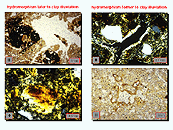
Paleohydromorphism
Both from the point of view of genesis and practical applications it is uttermost important to know whether hydromorphic features preserved in a soil are the result of present day hydromorphic conditions, or are on the contrary the result of an ancient hydromorphism which does not reflect the present day conditions in the soil.
Before making up one's mind with respect to the hydromorphism of a soil based on the existence of Mn and/or Fe nodules one has to study very cautiously whether the nodules are formed in situ or are inherited. This may be done by observing their boundaries: diffuse boundaries point irrefutably to an in situ formation, whereas sharp boundaries can be attributed to both in situ formed or inherited nodules.
When many quartz grains are protruding from the surface of a nodule, periods of dissolution posterior to its formation have to be considered, indicating that it is inherited or represents older conditions of hydromorphism.
Also the existence of chips at the surface of the nodule, abruptly interrupting its internal fabric, are a clear sign of an allochthonous origin.
Moreover the sand and silt sized mineral grains may help to elucidate the possible origin of the nodules; the mineralogy (including shape, size and distribution) of the enclosed grains in the nodules has to be the same as those of the grains in the groundmass to consider an in situ origin. Moreover, if all gravels in a soil are composed of Fe and Mn, and none of quartz, feldspar, quartzite of other rock fragments, they should logically be formed in situ.
In the case of paleohydromorphism, pedofeatures may have been noticeably altered by later pedogenic processes.
In some case one can clearly prove the paleo-character of the hydromorphism if the Fe/Mn coatings are intersected by yellow/reddish illuvial clay coatings or if nodules are strongly fragmented with illuvial clay coatings occurring between the fragments.